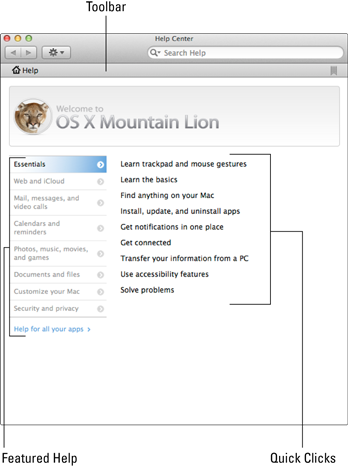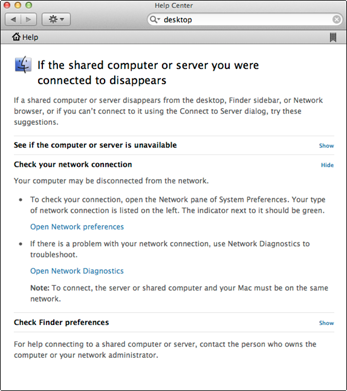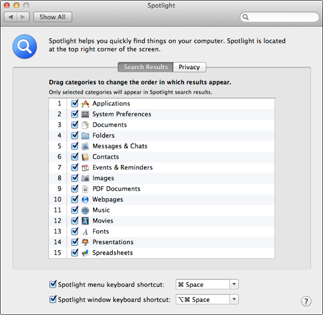Chapter 10: Getting Help for the Big X
In This Chapter
![]() Using the OS X Help Center
Using the OS X Help Center
![]() Searching for specific help
Searching for specific help
![]() Getting help in applications
Getting help in applications
![]() Finding other help resources
Finding other help resources
Whether the voice echoes from a living room, home office, or college computer lab, it’s all too familiar: a call for help. No matter how well written the application or how well designed the operating system, sooner or later, you’re going to need support. That goes for everyone from the novice to the experienced Mac owner and from the occasional e-mail user to the most talented software developer.
In this short but oh-so-important chapter, I lead you through the various help resources available within OS X as well as native OS X applications. I show you how to tap additional resources from Apple, and I also point you to other suppliers of high-quality (as well as even questionable) assistance on the Internet and in your local area.
Displaying the Help Center Window
Your first line of defense is the OS X Help Center, as shown in Figure 10-1. To display the Help Center from the Finder menu, click Help and choose Help Center. This Help menu is context-sensitive, so it contains different menu items when you’re working inside an application.
Figure 10-1: The reservoir of Mountain Lion assistance: the Help Center.

As shown in Figure 10-1, the Help Center is divided into three sets of controls:
![]() Toolbar: The toolbar includes navigational controls (Back, Forward, and Home buttons), an Action button (where you can print a topic or change the text size), and the Ask a Question (or Search Help) text box.
Toolbar: The toolbar includes navigational controls (Back, Forward, and Home buttons), an Action button (where you can print a topic or change the text size), and the Ask a Question (or Search Help) text box.
![]() Quick Clicks: Clicking these links takes you directly to some of the most frequently asked Help topics for the Finder (or the application you’re using), such as Learn Trackpad and Mouse Gestures and Find Anything on Your Mac. You can display different Quick Click selections by clicking a different topic in the Featured Help list that appears at the left of the Help Center window — rather like the top level in an outline. To use a Quick Click, just click (once) the question that you want to pursue.
Quick Clicks: Clicking these links takes you directly to some of the most frequently asked Help topics for the Finder (or the application you’re using), such as Learn Trackpad and Mouse Gestures and Find Anything on Your Mac. You can display different Quick Click selections by clicking a different topic in the Featured Help list that appears at the left of the Help Center window — rather like the top level in an outline. To use a Quick Click, just click (once) the question that you want to pursue.
![]() Featured Help: Click any of these links to display specific help for an OS X application or a group of items on a similar topic. To see the comprehensive list of application help icons, click the Help for All Your Apps link at the bottom of the window.
Featured Help: Click any of these links to display specific help for an OS X application or a group of items on a similar topic. To see the comprehensive list of application help icons, click the Help for All Your Apps link at the bottom of the window.
I know that the Help Center looks a little sparse at first glance. However, when you realize how much information has to be covered to help someone with an operating system — check out the size of the book you’re holding, for instance — you get an idea of why OS X doesn’t try to cover everything on one screen. Instead, you get the one tool that does it all: the Spotlight search box.
Searching for Specific Stuff
To search for the Help topic you need, here are two paths to righteousness:
![]() From the Finder Help menu: Wowzers! In Mountain Lion, you don’t even have to open the Help Center to search for assistance on a specific topic. Just choose Help from the Finder menu (or press the
From the Finder Help menu: Wowzers! In Mountain Lion, you don’t even have to open the Help Center to search for assistance on a specific topic. Just choose Help from the Finder menu (or press the ![]() +Shift+/ shortcut). Click in the Search field right there in the menu, and then type a keyword or two.
+Shift+/ shortcut). Click in the Search field right there in the menu, and then type a keyword or two.
 Although you can ask a full-sentence question, I find that the shorter and more concise your search criteria are, the more relevant your results are.
Although you can ask a full-sentence question, I find that the shorter and more concise your search criteria are, the more relevant your results are.
Like when using the Spotlight Search box, you don’t need to press Return; just click the topic that sounds the most helpful.
![]() From the Help Center: Click in the Search Help text box at the right side of the toolbar, type one or two words that sum up your question, and then press Return. Figure 10-2 illustrates a typical set of topics concerning the Desktop.
From the Help Center: Click in the Search Help text box at the right side of the toolbar, type one or two words that sum up your question, and then press Return. Figure 10-2 illustrates a typical set of topics concerning the Desktop.
You can double-click any topic to display the topic text, which looks like the text that you see in Figure 10-3. Note that you can expand topics to reveal additional information by clicking the Show link next to each major heading. To tidy up, click the Hide link, and any information displayed under that heading disappears.
Figure 10-2: The results of a search within the Help Viewer.

Figure 10-3: A typical topic within the Help Center.

To move back to the previous topic that you chose, click the Back button on the Help Center toolbar.
Prodding Apple for the Latest Gossip
I heartily recommend that you visit the Apple website at www.apple.com
and surf wildly to and fro. You’ll often pick up on news and reviews that you won’t find anywhere else on the Internet.
![]() Articles about the latest news from Cupertino
Articles about the latest news from Cupertino
![]() Downloads of the latest OS X freeware, shareware, and demoware
Downloads of the latest OS X freeware, shareware, and demoware
![]() The Knowledge Base (an online searchable troubleshooting reference)
The Knowledge Base (an online searchable troubleshooting reference)
![]() News about upcoming versions of OS X and Apple applications galore
News about upcoming versions of OS X and Apple applications galore
You’ll also find OS X product manuals in Adobe Acrobat PDF format and online discussion forums that cover OS X.
Calling for Help Deep in the Heart of X
A number of different help avenues are available within OS X applications as well. They include
![]() The Help button: A number of otherwise upstanding OS X windows, dialogs, and System Preference panes include a Help button, as shown in the lower right of Figure 10-4. Click the button marked with a question mark (?) to display the text for the settings in that dialog or window.
The Help button: A number of otherwise upstanding OS X windows, dialogs, and System Preference panes include a Help button, as shown in the lower right of Figure 10-4. Click the button marked with a question mark (?) to display the text for the settings in that dialog or window.
![]() Pop-up help for fields and controls: Most OS X applications display a short line of help text when you hover the mouse pointer on top of a field or control. Sometimes it’s just the name of the item; sometimes it’s a full descriptive line. Them’s the breaks.
Pop-up help for fields and controls: Most OS X applications display a short line of help text when you hover the mouse pointer on top of a field or control. Sometimes it’s just the name of the item; sometimes it’s a full descriptive line. Them’s the breaks.
![]() Application-specific help: Applications typically have their own Help system, which can use the Help Center window, a separate Help display program, or a HyperText Markup Language (HTML; read that web-based) Help system.
Application-specific help: Applications typically have their own Help system, which can use the Help Center window, a separate Help display program, or a HyperText Markup Language (HTML; read that web-based) Help system.
Figure 10-4: Notice the not-so-well-camouflaged Help button.

Other Resources to Chew On
Although the Help Center can take care of just about any question that you might have about the basic controls and features of OS X, you might also want to turn to other forms of help when the going gets a little rougher. In this last section, I cover resources that you can call on when the Help Center just isn’t enough.
Voice support
As of this writing, Apple provides voice technical support for OS X. You can find the number to call in your Mac’s printed manuals or online in the Support section of the Apple website. However, exactly when you qualify for voice support and exactly how long it lasts depends on a number of different factors, such as whether you received OS X when you bought a new machine or whether you purchased a support plan from Apple.
You can also try the general online support site at www.apple.com/ support
— it’s a great starting point for obtaining OS X help.
Mac publications and resource sites
You can refer to a number of great Mac-savvy publications and resources, both printed and online, for help. My favorites include
![]() Macworld (
Macworld (www.macworld.com
), both in archaic hard copy and oh-so-slick online versions
![]() Inside Mac Games (
Inside Mac Games (www.insidemacgames.com
), the online gaming resource for the Macintosh
![]() Download.com (
Download.com (www.versiontracker.com
), an online resource for the latest updates on all sorts of Macintosh third-party applications
![]() MacFixIt (
MacFixIt (www.macfixit.com
), a well-respected troubleshooting site devoted to the Mac that offers downloads, news, and discussion areas (a subscription may be required for some of the more useful sections of the site)
Local Mac outlets and user groups
Finally, you can find local resources in any medium-size to large town or city: A shop that’s authorized by Apple to sell and repair Macintosh computers can usually be counted upon to answer a quick question over the phone or provide more substantial support for a fee. (For example, my local Mac outlet sponsors inexpensive classes for new Mac owners, and if you can reach an Apple Store, the Genius Bar is a great resource.)
You might also be lucky enough to have a local Macintosh user group that you can join — members can be counted on for free answers to your support questions at meetings and demonstrations. To find a group near you, visit the Apple User Group Support site at www.apple.com/usergroups
and click the Find a Group link.

 Within the Help Center window, articles taken from the AppleCare Support section of the Apple website appear in the Product Support portion of the window. (Of course, because web stuff is going on in the background, you don’t see these articles unless your Mac has an active Internet connection.)
Within the Help Center window, articles taken from the AppleCare Support section of the Apple website appear in the Product Support portion of the window. (Of course, because web stuff is going on in the background, you don’t see these articles unless your Mac has an active Internet connection.) In most of my books, I mention specific Internet newsgroups that cater to the topic I’m discussing; however, virtually all Mac-specific newsgroups are devoted to illegally swapping pirated games and applications, so I don’t cover them. Also, the help that you receive from individuals in newsgroups is sometimes misguided — and sometimes downright
In most of my books, I mention specific Internet newsgroups that cater to the topic I’m discussing; however, virtually all Mac-specific newsgroups are devoted to illegally swapping pirated games and applications, so I don’t cover them. Also, the help that you receive from individuals in newsgroups is sometimes misguided — and sometimes downright  As a general rule,
As a general rule,